
The nuts and bolts of the Rán 4 TP52
In the six years since the TP52 class made its debut in Europe on the MedCup, a huge amount of knowledge about the boats has been accumulated and a handful of TP52 ‘specialists’ have emerged. One of the foremost is Australian Chris Hosking who masterminded the conception and build of Niklas Zennström’s new Rán 4, which, like the team’s 72ft Mini Maxi, Rán 2, was designed by Judel-Vrolijk and built by Green Marine in Lymington.
Impressively this is Hosking’s fifth TP52 project in six years, starting with Michael Illbruck’s Pinta in 2006, followed by three Artemis campaigns over 2007-9, including Torbjorn Tornqvist’s 2007 Audi MedCup winner, before taking a year out of the class in 2010 to take on the no-small task of looking after the Rán 2 Mini Maxi.

While the 2008 Artemis was a Reichel-Pugh design, the rest have been Judel-Vrolijks and Hosking says that in addition to him they have managed to maintain a similar team throughout all these projects, from designers Rolf Vrolijk and Tobias Kohler to structural engineer Steve Koopman at SDK Structures, to what is now the Rán shore team, including riggers Cam Marshall and Robin Hilton, their German boatbuilder Jan ‘Nipper’ Klingmueller and ex-Team NZ/Alinghi sailmaker Andrew Witherspoon. “They were all previously with us at Artemis, Cam was with Mean Machine and Nipper has been with us since Pinta,” says Hosking. “We have become a bit like a family. Between the four of us we know the boats quite well and we certainly know how one another operate.”
As mentioned in our first article, the new 2011 TP52s are different animals to previous generations thanks to the changes in the class rule. In terms of performance, the most significant change has been the effective moving of the huge amount of internal ballast down to the bulb. Previous generation TP52s were typically carting 500-800kg of lead around in their bilge while in more meticulously constructed boats it swelled to as much as 1,200kg. Bulbs on the top boats were around 3 tonnes but now under the new rule maximum bulb weight is 3.8T, making the latest TP52 considerably stiffer and also a little longer on the waterline.
But the brain power applied by the likes of Hosking and his team has gone from endless tweaking of minutae, such as increasingly ingenious methods of reducing windage on the pit winch, to the wider issues thrown up by the new class rule’s removal of the vertical centre of gravity limit. The most evident effect of this on the new Rán is her minimum freeboard, minimum deck camber and the cockpit sole which has been dropped down as low as permissible under the rule.
Another of the general concepts behind the new TP52 rule amendments was to create a more all-purpose boat, converging with what a 52ft grand prix boat designed to race under IRC might be. For example last year it became mandatory for all new builds to have plan approval from the Germanischer Lloyd classification society. As a result the latest TP52s are both structurally stiffer and should also have a longer lifespan than their predecessors. Specifically GL approval has upped the panel weights and scantling requirements, while Hosking gives the example of the rudders which GL have required to be slightly bigger and much heavier than they were before.
While a slightly painful addition to the design process, Hosking views GL’s involvement generally to be good. “There was a period around 2006-2007 where the boats were getting very Audi MedCup-specific and you wouldn’t have wanted to take them offshore.”
Via the class rule, booms have also increased in weight – now up to 35kg with a lot more carbon fibre in them. As Hoskings says: “I’d be happy to take the boat to Hobart now.” In fact, aside from the addition of some pipe-cots below, there is precious little else which would be required to make the boat competitive under IRC and safe to go offshore (although ideally one would prefer more freeboard and a deeper cockpit). For example the new TP52s are obliged to feature a galley and now there is even a minimum spec for the cooker. “In the past it was unrestricted in size and weight, so we were making stupidly small light little things that if you tied the sail ties on to them they’d break in half!” recalls Hosking.
The only slightly awkward part of making one of the new TP52s comply with the ORC Special Regs is the head - on a TP52 this is can still be a ‘fitted bucket’ under the new rule, whereas for the Special Regs it would need to be a fully plumbed in marine head.
“Some of those rule introductions, we look at them and go ‘well that is a little bit painful, because we know we’ll never use the cooker’, for example, but when the boat is sold someone will use the cooker on a delivery or on a long offshore and they’ll be happy that it is in there,” says Hosking. “I think those parts of the rule, even though they will never see the light of day for us, they are better for the boats in the future.”
The most significant new technological development featuring on some of the TP52s this year are the new Southern Spars rigs built using their Thin Ply Technology (TPT), central to North’s 3Di sails. This allows the rig to be engineered in fully multi-axial carbon fibre, and given there is a minimum weight for the TP52 masts, the TPT rigs are substantially stiffer. We’ll go into more detail about this imminently...
Also unusual about Rán’s rig is the height and length of the boom. The boom is minimum length (E = >7m) allowing for the highest aspect sail plan and when looking at the boat the boom seems a long way off the deck and cockpit. In fact this is because the boat has minimum deck camber (1 deg), giving the appearance that the rig is higher up than normal.
Skipper Tim Powell describes a side-effect of this: “The BAS [boom above sheerline] has stayed the same since TPs came out but everything has dropped away so far that you can’t look up the mast to check the mast tune, which is quite difficult...” They now carry a fender to help elevate him.
The short boom has also required the 2m long main sheet track be moved forward and this in turn has forced the aft pedestal to be positioned immediately to starboard of the rudder stock, potentially restricting the movement of the tiller. Hosking describes how they have got around this: “We have had to rake the pedestal and mount the fore and aft drive train quite a bit off the centre line of the yacht in order for the tiller to be able to turn the boat to port. I think we can turn the tiller 40°. I’ve parked the boat a couple of times and it seems to be working okay.”
The tiller is also a little longer than on previous boats.
As mentioned - in previous years some teams have experimented with moving the pit winch into the companionway to reduce windage. This has now been outlawed and there are restrictions on its positioning in relation to the sheer and height above the cockpit sole. So on Rán 4 the pit winch sits on its own island offset to starboard aft of the cockpit bulkhead. But aside from being used to hoist the spinnaker staysail or the jib or for a tack line as a safety on the A3 if it becomes highly loaded, this winch is just used as a snubber and Hoskings reckons its purpose is nearly redundant.
“You might find your offside trimmer or your pitman are doing a lot of their work on the free weather primary,” continues Hosking. “We are set up so that all the halyards come down through the rig, exit out the back of the rig, through the jammers - and that is direct line lead from the mast base sheaves in the rig to the primary at a 5 degree line entry lead angle for the winches, so there is absolutely no friction. Then if we do an Indian around the top mark, we have a small organiser in the pit to transfer across to the port primary.”
The cockpit has six winches, both primaries being Harken 650s with slave rings and self tailers. “They are a standard, reliable winch with no mods to them,” endorses Hosking.
A new feature, immediately forward of the tiller, mounted on the cockpit pole, is a neat panel for the main sheet controls, traveller, Cunningham, outhaul and the adjustable tack offset. “If the mainsail trimmer needs to adjust the outhaul, Cunningham or main tack he just reaches in and grabs it - I got that idea from the Etchells,” says Hosking. “They have that pod in the middle of the boat and I always thought that was quite a neat way, rather than having two ends of a purchase system led to either side which gets quite messy.” All are on long cascades below deck [Hosking won’t be specific about their ratios] and allowing them to be operated without the need of a winch.
Tack offset? Hosking explains what this is: “Just another mainsail control to control mainsail depth in the bottom panel. Some could argue that going around the top mark, you'd ease this control rather than the outhaul to effectively increase the mainsail area when going downwind. I think the 12 meters used to do this. We still ease the outhaul around the top mark though...”
This cockpit floor-mounted panel is another example of the desire to lower the VCG. “Boycey [Jonathan Taylor] at TT Rigging has done quite a bit of work on the rope, trying to get rope that is strong enough to deal with the loads but won’t fill with water. With Robin and Cam - the three of them have done the ropework.”
The vang is separate, its control line emerging out of the cockpit sole just aft and to port of the rudder stock. “That is a pretty much a pre-set thing up to around 18 knots when you start to heat it up and get going. Then we’ll have a guy stood down the back of the boat playing the vang,” says Hosking.
The traveller is a Harken ProTrim, Lou Varney special. “We have been running them for a while,” says Hosking. “We put the first one in in 2007 on Artemis. It has been a testing and development thing ever since, but I think we have got that nailed. I think it is a really nice system.”
The controls for the sheet leads on the sidedecks are via a set of jammers mounted into recesses on the cockpit side. So on the port side front to back for example is the spinnaker staysail barber hauler, the jib tack Cunningham, jib in, jib out, jib up/down. “The jib tack Cunningham is also connected to the headstay ram, so we have got control of that, and as we adjust the rake we also can adjust the luff tension of the sail in proportion,” says Hosking.
Compared to the more extensive systems that are believed to be fitted on the other new TP52s, on Rán 4 the only hydraulics is the ram for the headstay.

In terms of standing rigging, for some reason (presumably cost?) the TP52 rule prohibits composite standing rigging. Thus Rán 4 has Nitronic rod although with the significant change in righting moment of the new boats the spec has changed and Hosking says they have had to increase the diameters of the Vs. The shrouds on Rán neatly terminate at below deck chainplates.
The running backstays are Future Fibres Flex C (soft carbon), but Hosking says they have also ordered a second set in Southern Spars’ EC6. “There is so much propaganda going on out there between these companies it is hard to know who to believe any more... We needed a spare set of backstays anyway, so the option was there to have some from each company and they agreed to spec the same - which is nearly impossible! So we’ll see for ourselves.”

As normal, the forestay (also Nitronic) is mounted in a trough. “The whole concept of the tack trough is just to try and start the end plate effect with the jib,” says Hosking. “If you have a gaping hole there the end plate moves along the foot of the sail. The tack isn’t above the sheer for the whole rake range.”
There is 255mm of adjustability in the headstay ram and this is powered by the pedestals, as is the spinnaker take-down system. On the Rán Mini Maxi the take-down line went over a roller on the aft underside of the foredeck hatch, disappeared down the port side to the transom, returned up the starboard side to a pedestal powered winch mounted below the cockpit sole. However Hosking won’t be specific about the system they have on the 52, other than it all happens below deck (rather than the line feeding back into the cockpit).
We will look forward with interest to see how the new Rán 4 behaves when she lines up against several of the other new generation TP52s at Palmavela next week.
More fine images from Christophe Launay/www.sealaunay.com
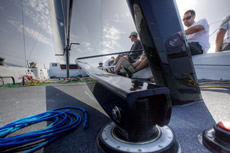 |
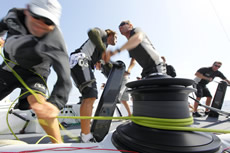 |
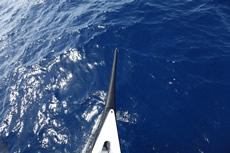 |
 |
 |
 |
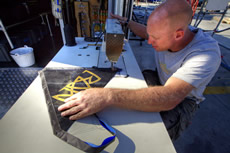 |
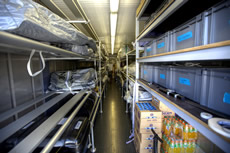 |
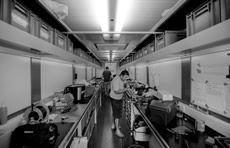 |
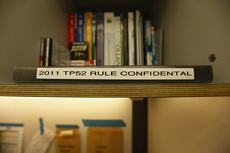 |
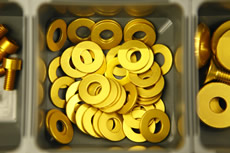 |
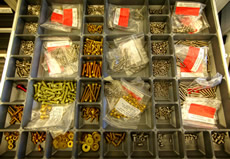 |
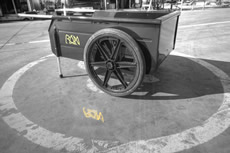 |
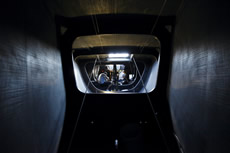 |
 |
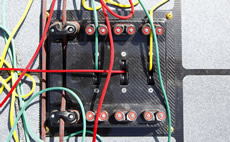 |
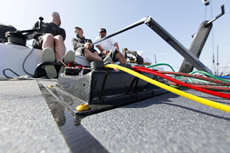 |
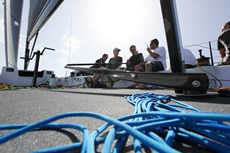 |
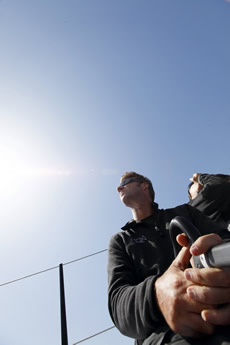 |


















Latest Comments
sinan 19/04/2011 - 13:15
What's an "indian around the top mark"?Add a comment - Members log in